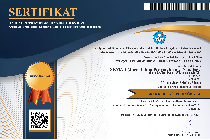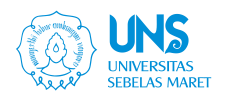Mentoring for Textile Liquid Waste Management and Occupational Safety Improvement in Lurik Asri Fabric Center, Klaten
Abstract
Full Text:
PDFReferences
Adji, P. S., & Wayuningsih, N. (2018). Kain Lurik: Upaya Pelestarian Kearifan Lokal. Atrat, 6(2).
Afifudin, M. (2019). Melaksanakan prosedur kesehatan dan keselamatan kerja. In CV Sarnu Untung.
Dwipasari, L., & Subianto, T. (2018). Pendampingan pengembangan kub (kelompok usaha bersama) batik malangan di kota malang. Jurnal Pengabdian Masyarakat Universitas Merdeka Malang, 2 (2). https://doi.org/10.26905/abdimas.v2i2.1816
Ensiklopedi Nasional Indonesia. (1997). Delta Pemungkas. https://books.google.co.kr/books?id=3CrkPgAACAAJ
Fitriani, M., & Josef, A. I. (2021). Kajian Proses Perancangan Lurik Bemberg Pewarna Alam Klaten. Dimensi: Jurnal Ilmiah Komunikasi Dan Seni Desain Grafis, 2 (2).
Haryono, H., Faizal D, M., Liamita N, C., & Rostika, A. (2018). Pengolahan Limbah Zat Warna Tekstil Terdispersi dengan Metode Elektroflotasi. EduChemia (Jurnal Kimia Dan Pendidikan), 3(1). https://doi.org/10.30870/educhemia.v3i1.2625
Komarawidjaja, W. (2016). Sebaran Limbah Cair Industri Tekstil dan Dampaknya di Beberapa Desa Kecamatan Rancaekek Kabupaten Bandung. Jurnal Teknologi Lingkungan, 17 (2). https://doi.org/10.29122/jtl.v17i2.1045
Maghfiroh, M., Astuti, S. P., & Kurdi, M. (2018). Karakterisasi dan Komparasi Parameter Pencemar Limbah Cair Batik Zat Warna Alam dan Zat Warna Sintetis Golongan Bejana. Jukung (Jurnal Teknik Lingkungan), 4(2). https://doi.org/10.20527/jukung.v4i2.6579
Manihuruk, C. P., & Tirtayasa, S. (2020). Pengaruh Stres Kerja, Motivasi Kerja dan Lingkungan Kerja Terhadap Semangat Kerja Pegawai. In Jurnal Imliah Magister Manajamen (Vol. 3, Issue 2).
Mirawati, D. K., Budianto, P., Prabaningtyas, H. R., Putra, S. E., Hafizhan, M., Susilo, W. A., & Santosa, N. A. (2021). Penyuluhan Dampak Lama Waktu Membatik dengan Kejadian Carpal Tunnel Syndrome (CTS) di Kampoeng Batik Laweyan. SEMAR (Jurnal Ilmu Pengetahuan, Teknologi, Dan Seni Bagi Masyarakat), 10(1). https://doi.org/10.20961/semar.v10i1.45576
M.P., E., D.A., R., D.U., A., & S., I. (2021). Potensi Teknologi pada Unit Instalasi Pengolahan Air Limbah (IPAL) sebagai Solusi Pengolahan Air Limbah pada Industri Tekstil di Indonesia. Prosiding Seminar Industri Hijau.
Purwaningsih, L. (2022). Relasi Motif Kain Lurik Jawa dan Makna Spiritualitasnya. In Concept: Journal of Social Humanities and Education (Vol. 1, Issue 4).
Sedjati, D. P., & Yantari, Z. A. P. (2021). Eksperimentasi Kluwih (Artocarpus camansi) sebagai Warna Alam pada Tekstil. Ars: Jurnal Seni Rupa Dan Desain, 24(1). https://doi.org/10.24821/ars.v24i1.4469
Sejati. (2020). Efektivitas Pengolahan Air Limbah Batik dengan Cara Kimia dan Biologi. Majalah Ilmiah, 22(1).
Setiyaning, K. A., & Nugroho, P. (2017). The role of batik and lurik in forming local identity in klaten regency based on public perception. Journal of Regional and City Planning, 28(1). https://doi.org/10.5614/jrcp.2017.28.1.3
Sitanggang, P. Y. (2017). Pengolahan Limbah Tekstil Dan Batik Di Indonesia. Jurnal Teknik Lingkungan, 1(12).
Tiara, M., Muharni, M., & Nurnawati, E. (2022). Bioadsorpsi zat warna direct red 80 menggunakan bakteri indigen dari limbah industri kain jumputan. Sriwijaya Bioscientia, 2(2). https://doi.org/10.24233/sribios.2.2.2021.350
Wiwin Ainis Rohtih, & Mokh Afifuddin. (2023). Increasing the Competence of Village Youth Communities through the Introduction of Cultural Experience and Knowledge in Local Wisdom. Soeropati: Journal of Community Service, 5(2), 138–146. https://doi.org/10.35891/js.v5i2.4022























